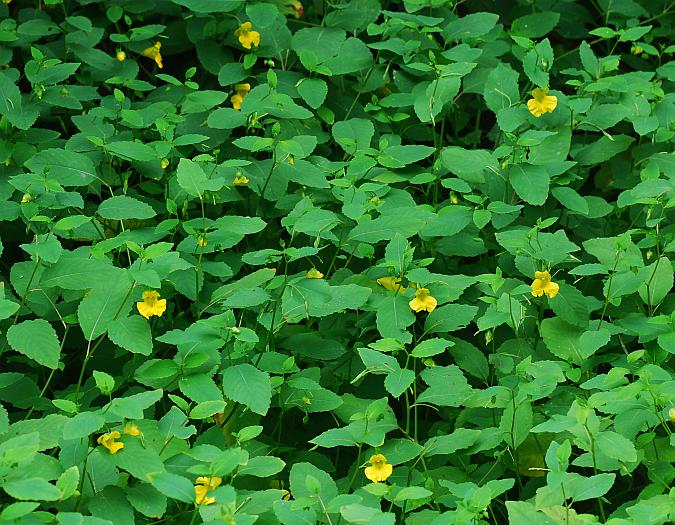Impatiens pallida Nutt.
Jewelweed

Native
CC = 5
CW = -3
MOC = 54
© SRTurner
Impatiens pallida Nutt.Jewelweed | |
 |
Native CC = 5 CW = -3 MOC = 54 |
© SRTurner |
|
Family - Balsaminaceae Habit - Annual forb. Stem - Ascending, to 1.5 m, succulent, often branched, hollow between nodes, glabrous, usually glaucous.
Leaves - Alternate, simple, petiolate, glabrous. Blades to 20 cm, ovate to elliptic, narrowed or tapered to the petiole, narrowed to the bluntly or sharply pointed tip, the margins scalloped or bluntly toothed with 9 or more teeth per side, the teeth usually ending in minute, sharp points, the basal portion (but not the petiole) sometimes with few to several small-stalked, dark-colored glands, the surfaces somewhat glaucous.
Inflorescences - Solitary axial flowers or more commonly of small panicles of 2-5 flowers.
Flowers - Zygomorphic, lemon yellow, usually with red spots, perfect, hypogynous, stalked, twisted at the base during development so that the top of the flower is oriented toward the bottom at maturity (resupinate). Sepals 3, the apparent lowest one petaloid and inflated into a conical pouch, this 10-19 mm long, tapered to a slender nectar-producing spur 4-6 mm long, this abruptly bent, the two lateral sepals 2-7 mm long, free, somewhat cupping the flower, broadly and obliquely ovate, tapered abruptly to a sharply pointed tip, pale green. Petals 5, but appearing as 3, each of the 2 apparent lateral ones lobed, representing a fused pair, the single apparently upper petal free, wider than long, and keeled. Stamens 5, the filaments short and flat, fused toward the tips, each with a scalelike appendage on the inner side, these appendages fused into a cap over the pistil, the short, stout anthers often also somewhat fused, the whole complex of stamens and cap shed as a unit before the stigmas mature. Pistil 1 per flower, of 5 fused carpels, the ovary superior, 5-locular, the placentation axile. Ovules 3 to many per locule. Style absent or very short, the stigmas 5, minute.
Fruits - 1.4-2.0 cm long, elliptic to oblanceolate in outline, violently dehiscent when mature. Seeds 5-6 mm long, elliptic-ovate in outline, the tip nipplelike or beaklike, strongly and irregularly 4-angled, the surface with a network of low ridges, sometimes appearing irregularly warty, dark brown.
Flowering - June - September. Habitat - Streambanks, sloughs, pond margins, swamps, bottomland forests, bluff bases, moist areas. Origin - Native to the U.S. Lookalikes - I. capensis is vegetatively similar. Other info. - This interesting species is found across most of Missouri as well as the northeastern quadrant of the continental U.S., and also ranges into Canada. Identification is easy when the plant is flowering. Plants which are not blooming can also be identified without too much trouble. The foliage is somewhat lax and herbaceous, often glaucous, and with distinctive scallops on the leaf margins. This description also applies to I. capensis, but the leaves of that species generally have fewer than 9 teeth on each side of the leaf, whereas Impatiens pallida leaves have more than 9 teeth per side. Thanks are due to Justin Thomas and associates for this character, which seems to be entirely reliable. Photographs taken at Faust County Park, St. Louis County, MO, 6-28-2010, along the Katy Trail west of Dutzow, Warren County, MO, 8-10-2014, and near Labadie, Franklin County, MO, 7-21-2019 (SRTurner). |